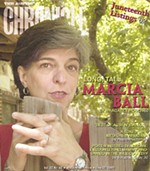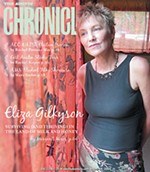Carlos Pineda and the YLA Exhibit
By Belinda Acosta, Fri., Sept. 14, 2007
Now, there's another reason to cheer. A retrospective of Pineda's work, "Hacia la Vida," is the first official exhibit of the MACC gallery, alongside Mexic-Arte's Young Latino Artists 12 exhibit, "Embracing Chaos," featuring the work of artists from across Texas younger than 30. "Hacia la Vida" features 44 pieces created by Pineda between 1967 and 2007. Some are still lifes, but most are portraits of famous and not-so-famous Mexican-Americans: Lydia Mendoza, Ruben Ramos, writer David Rice, and Austin native Tomás Salas, among others.
"Each portrait is a humble attempt to reflect internal, spiritual qualities and external, physical attributes," Pineda says in his artist's statement. More to the point, however: "[I wanted to show] that [Mexican-Americans and Chicanos] have as much dignity, power, and humanity as anyone else on earth."
Coming of age when segregation was standard and racism overt, Pineda decided to paint portraits out of more than an artistic choice; it was a political statement, though Pineda might not see it that way. "I like people. I'm very pleased to be directly opposite the young artists," Pineda says. "From what I've seen of the past [YLA exhibits], they're very contemporary, more experimental. I'm very conservative. I do one thing, and I'm proud of what I do."
The gulf between Pineda and the emerging artists is not as wide as one might suspect. In a continuing, unspoken commentary on the Mexican capacity to make art from ordinary or discarded objects, many of Pineda's portraits are painted on white window shades. Among the YLA pieces, some of the most stunning works blend embroidery on partially dyed fabric and frames decoupaged with pattern pieces one might find in a mother's sewing stash. "It has never been a problem for us if an art or craft object served in a practical or sacred manner. On the contrary, it was created for a specific purpose without losing its artistic merit."
There is poetry in this continuum of the past reflected in "Hacia la Vida" and "Embracing Chaos" and in the lack of distinction between "fine" and "folk" art that Pineda vehemently defends in his work and in the work of artists who influenced him – his uncle, who made beautiful baskets from recycled wire; his aunt, who made colorful piñatas from broken clay pots; the railroad workers of his youth, who made comals for their wives from scrap metal found in rail yards. Today, it's called "thinking green," but for Pineda and a new generation of artists, it's an unending desire to find beauty in the ordinary and, more importantly, to celebrate that marriage of art and culture with dignity, spirit, and delight.








